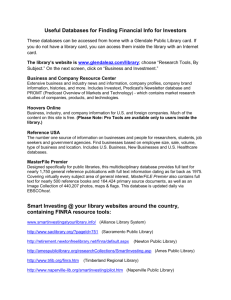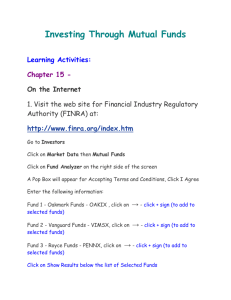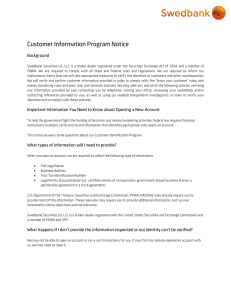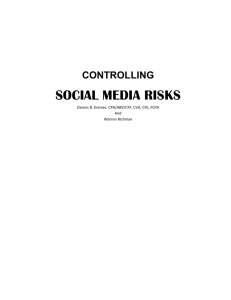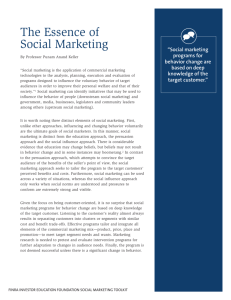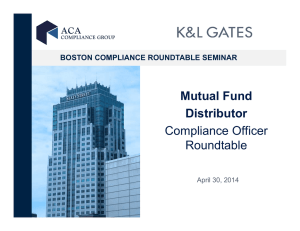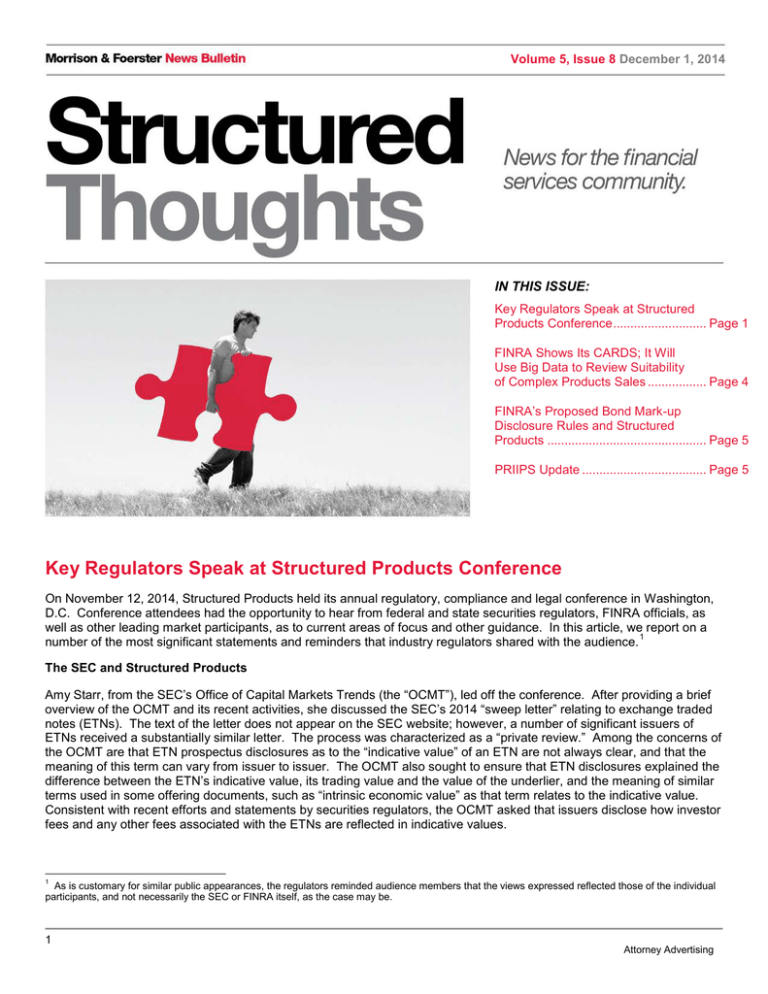
Volume 5, Issue 8 December 1, 2014
IN THIS ISSUE:
Key Regulators Speak at Structured
Products Conference ........................... Page 1
FINRA Shows Its CARDS; It Will
Use Big Data to Review Suitability
of Complex Products Sales ................. Page 4
FINRA’s Proposed Bond Mark-up
Disclosure Rules and Structured
Products .............................................. Page 5
PRIIPS Update .................................... Page 5
Key Regulators Speak at Structured Products Conference
On November 12, 2014, Structured Products held its annual regulatory, compliance and legal conference in Washington,
D.C. Conference attendees had the opportunity to hear from federal and state securities regulators, FINRA officials, as
well as other leading market participants, as to current areas of focus and other guidance. In this article, we report on a
1
number of the most significant statements and reminders that industry regulators shared with the audience.
The SEC and Structured Products
Amy Starr, from the SEC’s Office of Capital Markets Trends (the “OCMT”), led off the conference. After providing a brief
overview of the OCMT and its recent activities, she discussed the SEC’s 2014 “sweep letter” relating to exchange traded
notes (ETNs). The text of the letter does not appear on the SEC website; however, a number of significant issuers of
ETNs received a substantially similar letter. The process was characterized as a “private review.” Among the concerns of
the OCMT are that ETN prospectus disclosures as to the “indicative value” of an ETN are not always clear, and that the
meaning of this term can vary from issuer to issuer. The OCMT also sought to ensure that ETN disclosures explained the
difference between the ETN’s indicative value, its trading value and the value of the underlier, and the meaning of similar
terms used in some offering documents, such as “intrinsic economic value” as that term relates to the indicative value.
Consistent with recent efforts and statements by securities regulators, the OCMT asked that issuers disclose how investor
fees and any other fees associated with the ETNs are reflected in indicative values.
1
As is customary for similar public appearances, the regulators reminded audience members that the views expressed reflected those of the individual
participants, and not necessarily the SEC or FINRA itself, as the case may be.
1
Attorney Advertising
Volume 5, Issue 8 December 1, 2014
Ms. Starr next focused on issues relating to the selection of underlying assets relating to SEC-registered structured
2
products. She discussed the OCMT’s views relating to the SEC’s 1996 “Morgan Stanley” no action letter, indicating that
the OCMT believed that it remained relevant guidance for market participants today. There are a number of ways in
which the letter affects prevailing practices in the registered market:
•
Per the OCMT’s 2012 sweep letter to structured note issuers, issuers should not disclaim responsibility for the
accuracy of information included in a prospectus about an underlying asset.
•
Non-actively managed exchanged traded funds, such as those that track a broad market index, remain eligible for
use as reference assets in registered structured products; however, the OCMT does not believe that actively
managed ETFs are eligible reference assets for a SEC-registered product.
•
Credit-linked notes, in which the return of the structured product would depend upon whether or not a “credit
event” occurs as to one or more underlying issuers, were not viewed as permissible for SEC-registered notes.
There is a degree of doubt as to whether an underlying issuer’s 1934 Act reports would include information that
investors could readily access in order to determine whether such an event occurred.
•
Notes linked to hedge funds and hedge fund indices would not be appropriate for SEC-registered notes, due to
the lack of public information about the underlying hedge funds and their strategies.
Market participants were also reminded to consider the disclosures and other potential issues when a registered note is
linked to an index that has a high concentration of one or more particular stocks. In these cases, an investor’s return may
depend to a large extent on the index components that represent a significant concentration in the index.
Outside of the context of registered securities, practices may differ in some cases. For example, the audience was
reminded that structured products that are not issued pursuant to a registration statement, such as structured CDs, bank
notes, Rule 144A offerings and Regulation D offerings, were outside the scope of the Morgan Stanley letter. Accordingly,
3
a broader range of underlying assets may be considered for use, as compared to a registered offering.
The Backtested Data Debate
A panel discussion among regulators vividly displayed the contrasting approaches of the U.S. securities regulators as to
the disclosure of backtested information (pre-inception performance) for indices.
To illustrate the starkness of the divide, here is a summary table:
SEC
FINRA
Permitted for use with retail investors, provided that the
presentation is appropriate.
Prohibited for use in retail communications by FINRA
members.
Amy Starr reiterated the view of the SEC staff that this type of information is permitted, as long as the information is
4
presented appropriately. Many of the guidelines identified in FINRA’s 2013 “ALPS letter” are appropriate to consider
here when this type of information is included in a prospectus.
In contrast, Tom Selman, FINRA’s Executive Vice President of Investment Companies Regulation, reiterated FINRA’s
view that this information is not permitted in retail communications under FINRA’s advertising rules. FINRA views it as
“fraught with peril,” due to potential data mining (“cherry picking”) and other issues. However, FINRA is currently
reviewing its advertising rules in all respects, and may (or may not) reconsider this position.
2
A copy of the letter may be found at the following link: http://media.mofo.com/files/Uploads/Images/Morgan-Stanley-6-24-1996.pdf.
Needless to say, issuers and distributors of such products would need to consider the adequacy of disclosures for such products, and potential
suitability issues relating to their sales.
4
That letter may be found at the following link: http://www.finra.org/Industry/Regulation/Guidance/InterpretiveLetters/P246651.
3
2
Attorney Advertising
Volume 5, Issue 8 December 1, 2014
FINRA and SEC Review of Broker Dealers
A panel discussion among various regulators indicated a number of key areas of regulatory focus. The panel consisted of
Daniel Gregus, Acting Associate Regional Director, Broker-Dealer Examinations, Chicago Regional Office of the SEC;
Reid Muoio, Deputy Chief, Structured New Products Unit, Division of Enforcement of the SEC; Mark Fernandez, Senior
Regional Counsel, Department of Enforcement of FINRA; and Ronak Patel, Deputy Securities Commissioner, of the
Texas State Securities Board. A number of the key issues addressed have come to the fore during the last two years, in
5
light of, for example, FINRA’s 2013 report on Conflicts of Interest.
KYD Procedures. Brokers are expected to review the third party distributors that sell the complex products that they
originate. Among the factors to consider are their sales practices, training, investor education efforts, and compliance
culture. FINRA members should review how these distributors code their sales of complex products, in order to identify
over-concentration or other potential issues. FINRA has endorsed, in appropriate cases, a “tiered distribution model,” to
reflect the possibility that some distributors may be selected to distribute only less complex products, but may not be
permitted to sell the more complicated product offerings.
Post-Issuance Review. Brokers are obligated to perform a post-issuance review after rolling out a new complex product.
A review would include, for example, an assessment of whether a product performed in accordance with its design, and
whether distributors and other sellers sold the product to the types of investors for which it was intended. Needless to
say, FINRA would be concerned if a product designed for institutional investors was shown to in fact frequently end up in
the hands of retail investors.
Reverse Inquiry Transactions. In reverse inquiry transactions, an investor seeks out a structured product with a specified
return profile. Appropriate KYD procedures and “reasonable basis suitability” determinations may also be needed for
these types of offerings as well, notwithstanding the fact that the broker itself did not initially conceive the instrument. In
addition, brokers should exercise appropriate caution, and perform appropriate approval procedures, before rolling out a
product that commenced as a reverse inquiry product to additional investors, particularly in the case of retail investors.
Branch Offices. In many cases, a broker’s branch offices may have fewer resources and, accordingly, less robust
procedures and training, than the broker’s main office. Mr. Fernandez noted that one of FINRA’s 2015 exam priorities will
be to help evaluate the risk matrix used in connection with branch offices, particularly in connection with sales of complex
products.
FINRA Advertising Rules
6
Since FINRA’s amended advertising rules went into effect in February 2013, a variety of interpretative questions have
7
arisen. FINRA attempted to resolve some of these questions in its 2014 rule amendments. Notwithstanding the
amendments, a variety of questions and different practices have emerged. As part of his presentation to the conference,
and subsequently as part of a panel, David Roscum, Manager of FINRA’s Advertising Regulation Department, attempted
to provide some clarification as to the application of the advertising rules and related filing requirements to structured
products.
Generic Materials. Generic materials, such as brochures relating to one or more different product types generally, are not
subject to the filing requirements. This is because such materials do not relate to “any [specific] security,” as that concept
is contemplated by FINRA Rule 2210(c)(3)(E). Instead, FINRA’s filing requirement, according to Mr. Roscum, relates to
retail communications that describe specific securities.
Who “Owns” the Free Writing Prospectus (FWP)? The filing rules exempt from FINRA filings most prospectuses and free
writing prospectuses that the issuer files with the SEC (FINRA Rule 2210(c)(7)(F)). In the case of an FWP in which both
the issuer and the underwriter have a role in preparation, including where the issuer is an affiliate of the underwriter,
5
The report may be found at the following link: http://www.finra.org/web/groups/industry/@ip/@reg/@guide/documents/industry/p359971.pdf.
These rules are set forth in FINRA Rule 2210.
7
Our discussion of these amendments may be found in the following newsletter:
http://www.mofo.com/~/media/Files/Newsletter/2014/08/140811StructuredThoughts.pdf.
6
3
Attorney Advertising
Volume 5, Issue 8 December 1, 2014
Mr. Roscum indicated that the issuer’s filing of the document under SEC Rule 433 would be sufficient to remove the
document from FINRA’s filing requirements.
Templates. Many types of FWPs, such as summary descriptions of particular types of offerings, repeat themselves on a
monthly or weekly basis. However, the FINRA filing rules were developed without the possibility of filing a single template
for multiple similar offerings. The FINRA advertising department would be open to the possibility of discussing with
issuers the possible approval of templates for multiple offerings, but with a single filing made.
Offerings Outside the Scope of the Advertising Rule. Mr. Roscum indicated that offerings conducted solely outside the
U.S., and offerings of structured certificates of deposit (which typically are not “securities”), are not within the scope of the
advertising rules, and the relevant offering documents should not be filed with FINRA.
As a general matter, FINRA believes that the quality of materials being filed with FINRA that relate to structured products
is improving. And where issuers thought they had documents or materials that might raise broader, more interesting,
questions under the FINRA rules, he encouraged brokers to reach out directly to their designated analyst in order to
discuss the form and content of the materials in question.
Conclusion
The Washington conference reflects the continued effort by market participants to understand, and comply with, their
regulatory requirements, as well as the regulators’ desire to understand and communicate with the market. Meetings of
this kind help ensure that investors benefit from the continuing improvement and refinement of industry practices.
FINRA Shows Its CARDS; It Will Use Big Data to Review Suitability of
Complex Products Sales
FINRA recently proposed a rule to implement the Comprehensive Automated Risk Data System (CARDS), a proposal to
formalize and regularize its efforts to gather and use “big data” as part of its exam program. In the face of push-back from
some parts of the broker-dealer industry, FINRA is not backing down, and as part of its justification for CARDS, it has
cited its usefulness in addressing possible unsuitable sales by firms of complex products that present higher risks to
customers.
A little background: according to recent FINRA Regulatory Notice 14-37, CARDS would allow FINRA to collect on a
standardized, automated and regular basis, account information, as well as account activity and security identification
information that a firm maintains as part of its books and records. This use of technology would enable FINRA to identify
and quickly respond to high-risk areas and suspicious activities that it might not identify through its current surveillance
and examination programs. In its initial phase, FINRA’s proposed rule would require clearing firms to periodically submit
in an automated, standardized format, specific information that is part of the firms’ books and records relating to their
securities accounts and the securities accounts for which they clear. In the second phase, fully disclosed introducing
firms would be required to submit specified account profile-related data elements either directly to FINRA or through a
third party. Amidst initial objections when FINRA first floated the proposal, FINRA cut back on the proposal by agreeing to
exclude the collection of personally identifiable information for customers, including account names, account addresses
and Social Security numbers.
At the recent SIFMA Complex Products Forum, Susan Axelrod, Executive Vice President, Regulatory Operations, drew
the connection between CARDS and structured products. She explained that having data in a standard format will allow
FINRA to track product mix across firms and in branches of each firm help monitor, on an ongoing basis, potential
unsuitable sales, where firms consistently sell products that present higher risk to customers compared to their risk
tolerance profiles. CARDS would also enable FINRA to quickly identify trends and product concentrations that are
harmful to investors and as examples of such products she cited to certain complex products that she had discussed in
her speech, such as steepeners, range accrual notes, and alt funds. Ms. Axelrod stated that CARDS would avoid the
need to respond to concerns about sales of a certain type of product with a sweep request to narrow down the firms that
4
Attorney Advertising
Volume 5, Issue 8 December 1, 2014
might be of concern, because FINRA would already have the data in-house to identify those firms. As she stated, “That
means we could immediately zero in on the firms that are actively selling suspect products to retail investors and may
have large, concentrated positions.” The touted result would be a more focused and less arduous exam process that
would lead to greater speed in protecting investors.
FINRA requested comments on the proposed rule by December 1, 2014, and it remains to be seen whether industry
pressures will lead to a further contraction of the proposal.
FINRA’s Proposed Bond Mark-up Disclosure Rules and Structured
Products
In FINRA’s November 2014 Regulatory Notice 14-52, FINRA proposed a new rule that would require broker-dealers to
8
disclose additional information on customer confirmations for transactions in fixed income securities. Under the proposal,
for same-day, retail-size principal transactions, broker-dealers would need to disclose on the customer confirmation (a)
the price to the customer, (b) the price to the broker of a transaction in the same security and (c) the difference between
9
those two prices.
The proposal reflects the recent push by U.S. regulators to enhance pricing transparency in the U.S. debt markets. For
example, in 2012, the SEC recommended that the MSRB consider requiring disclosure of pricing information to retail
investors, and senior SEC officials have focused on increasing the transparency of these markets.
The proposed rule relates to “corporate debt securities,” which would include many types of structured notes, including
Rule 144A securities. The proposal excludes “Money Market Instruments,” which are debt securities that have a maturity
of one year or less.
FINRA’s regulatory notice includes a variety of sample calculations and determinations, and requests comments from the
industry and other interested persons as to the proposed rules and their impact. The comment period will expire on
January 20, 2015.
PRIIPS Update
On November 17, 2014, the three European Supervisory Authorities, the European Securities and Markets Authority, the
European Banking Authority and the European Insurance and Occupational Pensions Authority, released a discussion
paper in relation to Key Information Document for PRIIPS. This follows the adoption by the Council of the EU of the final
form of the PRIIPS regulation earlier in November. The regulation requires the provision of a clear and succinct summary
document, containing key information for investors on the product and the issuer, whenever selling a packaged
investment product or insurance-based investment product to retail investors. The regulation requires a prescribed format
and content for the KID, in order to assist retail investors in analysing different types of PRIIPs products. The PRIIPS
regulation will take full effect early in 2017, but in the meantime, it envisages various technical standards being drafted by
the three ESAs, for adoption as delegated acts by the European Commission.
The discussion paper has been published in relation to various specific points under the PRIIPs regulation, namely the
details of the presentation and content of each element of the required KID content, the methodology underpinning the
presentation of risk and reward, such as the risk indicator and performance scenarios, and the methodology for
calculation of costs, including the specification of summary indicators. The risk and reward section of the discussion
8
Regulatory Notice 14-52 may be found in the following link:
http://www.finra.org/web/groups/industry/@ip/@reg/@notice/documents/notices/p601685.pdf.
9
The proposal reflects the attempt by FINRA and the Municipal Securities Rulemaking Board (“MSRB”) to coordinate their rulemaking in this area. The
MSRB has also published a notice soliciting comments on a similar proposal.
5
Attorney Advertising
Volume 5, Issue 8 December 1, 2014
paper focuses on issues such as defining risk and reward, defining market, credit and liquidity risk and the different
possible measures and ways of presenting each type of risk. These include various possible presentations of a summary
risk indicator in pictorial form. In relation to the costs section, the paper discusses different types of costs, and the
scenarios in which they can occur in relation to different types of PRIIP. It also explores different possible options for
presenting costs, including different visual way of presenting a summary costs indicator.
In addition to risk and reward and costs, the paper also discusses other elements of the required content of a KID,
including items such as the required comprehension alert. The paper provides further details on sections such as a
description of what a product is, what happens if the PRIIP manufacturer is unable to pay out, how long the product
should be held for and whether early redemption is possible, and how complaints can be made. It also discusses other
requirements, including the need for a regular review of the information contained in the KID and possible consequent
revision and re-publication of the KID, as well as the timing of delivery of the KID to the retail investor.
The three ESAs invite comments to be submitted by February 17, 2015, and they will use the feedback on the discussion
paper to prepare draft regulatory technical standards. They expect to publish a consultation on these technical standards
in the autumn of 2015. However, before this, there will be a consumer testing exercise organised by the European
Commission to assist the ESAs in developing the standards.
Contacts
Bradley Berman
New York
(212) 336-4177
bberman@mofo.com
Lloyd S. Harmetz
New York
(212) 468-8061
lharmetz@mofo.com
Peter J. Green
London
44 (20) 7920 4013
pgreen@mofo.com
Daniel Nathan
Washington, D.C.
(202) 887-1687
dnathan@mofo.com
Anna T. Pinedo
New York
(212) 468-8179
apinedo@mofo.com
Jeremy C. Jennings-Mares
London
44 (20) 7920 4072
jjenningsmares@mofo.com
For more updates, follow Thinkingcapmarkets, our Twitter feed: www.twitter.com/Thinkingcapmkts.
Morrison & Foerster has been named Structured Products Firm of the Year, Americas, 2014 by Structured Products magazine
for the sixth time in the last nine years. See the write-up at http://www.mofo.com/files/Uploads/Images/120530-AmericasAwards.pdf. Morrison & Foerster named Best Law Firm in the Americas, 2012, 2013, and 2014 by Structured Retail
Products.com.
Morrison & Foerster named Legal Leader, 2013 by mtn-i at its Americas Awards. Several of our 2013 transactions were also
granted awards of their own as a result of their innovation.
Morrison & Foerster named European Law Firm of the Year, 2013 by Derivatives Week at its Global Derivatives Awards.
About Morrison & Foerster
We are Morrison & Foerster—a global firm of exceptional credentials. Our clients include some of the largest financial institutions,
investment banks, Fortune 100, technology, and life sciences companies. We’ve been included on The American Lawyer’s A-List for
11 straight years, and Fortune named us one of the “100 Best Companies to Work For.” Our lawyers are committed to achieving
innovative and business-minded results for our clients, while preserving the differences that make us stronger. This is MoFo. Visit us
at www.mofo.com. © 2014 Morrison & Foerster LLP. All rights reserved.
Because of the generality of this update, the information provided herein may not be applicable in all situations and should not be acted
upon without specific legal advice based on particular situations.
6
Attorney Advertising

